The Barons of auchterhouse
The first proprietor of the barony of Auchterhouse, as stated in The Edinburgh Topographical Traditional and Antiquarian Magazine, Volume 1, is a John Mayne or Mein. He held, and was designated of it during the reign of Robert II. Part of the barony, as stated before, came to the Earl of Airlie before 1400. Parts, particularly the lands of Templeton, belonged to the Knights Templar. After suppression of the order, those lands, along with the other parts of the barony were given to Sir William Ramsay. This section will discuss the Barons of Auchterhouse as well as the families associated with them.
Influential Families
The Ramsays
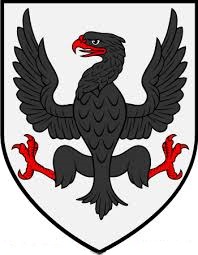
A ram in the sea is said to have been an emblem on the seal of Ramsay Abbey in Huntingdon in the 11th century. When David, Earl of Huntingdon, traveled north to claim his kingdom of Scotland in 1124, he was accompanied by many young Norman noblemen keen to share in their overlord’s heritage. These may have included Sir Symon de Ramesie who received a grant of land in Midlothian from David and who witnessed several important charters, including one to the monks of Holyrood in 1140.
1090 — The Viking and/or his son joined King Malcolm III of Scotland, and survived by robbing the natives.
1066 — A German Viking, the progenitor of the Ramsay clan, sailed with Duke William II to England, and fought alongside Norman troops at the Battle of Hastings. This is when the Ramsay Black Eagle battle emblem was produced.
Branches of the clan
The de Ramesie family prospered, and by the 13th century there were five, or even six, major branches: Dalhousie (Midlothian), Auchterhouse (Angus, aka Forfarshire), Bamff (Perthshire), Forthar (Fife), Clatto (Fife) and, probably, Colluthie (Fife). Peter de Ramsay, son of Nessus de Ramsay of Forthar, was appointed Bishop of Aberdeen in 1247 and, before his death in 1256, like William de Ramsay of Dalhousie, was a member of the king’s council in 1255 during the minority of Alexander III of Scotland. William’s son, or perhaps his grandson, also called William, appears on the Ragman Roll, swearing fealty to Edward I of England in 1296 as Ramsay de Dalwolsy, along with ten other Ramsay lairds from Angus, Fife, Midlothian and the borders.
Ramsay’s of Auchterhouse
Upon Edward I return to Scotland, on 22 August 1296, all the great territorial potentates, barons, knights, and leading church-men of Scotland presented themselves to take the oath of allegiance. On this list of the Scottish nobility, which is still preserved in the English archives, appears the name of Thomas de Ramsay, Baron of the lands of Ochterhouse, one of several spellings of Auchterhouse. The land was owned by the Ramsay family, who were hereditary Sheriffs of Angus and lords of Auchterhouse from the mid-13th century until 1390. (Boardman). There has been a castle at Auchterhouse since at least the 13th century.
Legend, and early poetry, states that a Ramsay, Sir John Ramsay of Auchterhouse to be exact, fought in William Wallace’s campaign from 1297-1303. It is said, that in 1303, Sir Jhon Ramsay of Ochtyrhouse was among 300 honored guests who were present when Sir William Wallace returned from Flanders. Legend claims Sir William stayed overnight at Auchterhouse Castle. Part of the structure of the castle became known as Wallace’s Tower in honor of that visit. Sir John is also said to have been with Edward Bruce during the Scottish conquest of Ireland (1317). He was depicted as a brave knight, and his conduct in battle was specifically noted. “Sir John Ramsay of Auchterhouse, with Squires Guthrie and Bisset are particularly mentioned as having distinguished themselves in this brilliant rencounter” (Carrick).
In 1309, King Robert the Bruce gave a charter to William de Vchterhous certain lands in the, which has later come to be known as Auchterhouse. William’s son, Malcolm, was the last Ramsay to hold the land. Having no male heir, his lands were passed to the Ogilvy family when his daughter, Isabel, married Sir Walter Ogilvy.
The Ogilvy family
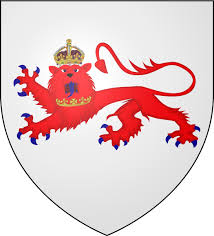
The Ogilvy’s are one of the most distinguished families in Scotland and take their name from Gillibride the second son of Gilliechriost, Earl of Angus, who acquired the Barony of Ogilvy in the Parish of Glamis in the mid-12th century. The name Ogilvy, or Ogilvie, derives from Gilbert, one of the descendants of the ancient Earls of Angus. The name is also believed to be derived from the Old British word Ocelfa meaning high plain. Sir Patrick de Ogilvy received the lands of Kettins in Angus. His name appears on the Ragman Roll swearing fealty to King Edward I of England in 1296. His name appears on the Ragman Roll However Patrick’s two sons supported King Robert I of Scotland during the Wars of Scottish Independence.
A decedent of Sir Patrick, Sir Walter Ogilvy of Wester Powrie and Auchterhouse, was appointed Hereditary Sheriff of Angus.
Barons of Auchterhouse and Sheriff of Fofar
Sir Walter Olgilvy (d. 1392) married Isabella Ramsay, only child and heiress of Malcolm of Auchterhouse, hereditary Sheriff of Fofar/Angus, in 1366. With that marriage, the lands of Auchterhouse and the shrievalty (office of the Sheriff), which was appendant to the land, passed to the Ogilvys. On 24 Oct 1385, King Robert II named Sir Walter Sheriff of Angus and Lord of Auchterhouse. Effectively naming him the 1st official Baron of Auchterhouse. He was killed at the battle of Glenbrierachan or Glasklune in 1392, repelling an inroad of Highlandmen, and is celebrated by the chronicler Wyntoun as “stout and manfull, bauld and wycht,” and as “godlike, wis, and wertuous”. Sir Walter and Isabella had had three sons, Sir Alexander being the oldest.
Sir Alexander Ogilvy of Auchterhouse, Sheriff of Fofar (d. btw 1421-1423). He was present at the Battle of Harlaw, and received many charters from King Robert III between 1398 and 1404, and as a reward for his services received from that king an annual rent out of the customs of Dundee. He obtained a safe-conduct to go to England, to treat for the liberation of King James I of Scotland, on 16 April 1413. This was extended until August 1413, and repeated in 1415. He died after 14 July 1421, when he sat as one of the Auditors of the royal revenues, and before 2 October 1423, when his son Patrick is designed Sheriff of Angus.
Sir Patrick Ogilvy of Grandon and Auchterhouse (d. after 1429). In 1425 he was an ambassador to France, and in the following year, one of the Auditors of the Crown revenues. On 14 April 1426 King James I confirmed a grant made by him, with his father’s consent, of an annual rent to the Chapel of St. Mary the Virgin of Garioch. In 1427, if not earlier, he was Justiciar of Scotland, north of the Forth. In 1429 Sir Patrick was made Constable of the Scots in France in succession to Sir John Stewart of Darnley. He was drowned at sea on his way home to Scotland. Around 1413, He married Christian, daughter and heiress of Sir Alexander Keith of Grandon. They had a daughter, Margaret, his sole heiress; who upon marriage to James Stewart before 1466, conveyed the estate and dignity of sheriff to him.
While in France, Sir Patrick provided 60 men-at-arms and 300 archers in support of Joan of Arc. He and his archers subsequently attended the coronation of Charles VIII in Reims.
The Stewart family
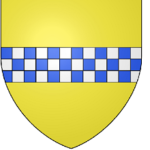
The Stewarts formed one of the most enduring and turbulent royal dynasties in Scottish history. Through war, policy and marriage they dragged Scotland from the margins of European affairs to center stage and, almost incredibly, they took the crown of the old enemy – England.
Originating from Brittany, the family name had been Fitzalan. This was changed after Walter Fitzalan entered the service of David I of Scotland (reigning from 1124 – 1153) and was appointed High Steward of Scotland. Walter’s great grandson later adopted the title as a surname and the family became the Stewarts.
Over the course of generations, the family accrued honors and lands but it was not until 1315 that fortunes truly changed. That year Walter, 6th High Steward of Scotland married Marjory Bruce, daughter of Robert the Bruce, King of Scots. Importantly the children of this marriage would have a direct blood-line claim to the throne of Scotland.
Barons of Auchterhouse
James “Hearty James” Stewart, 1st Earl of Buchan (d.1499) was the second son of Sir James Stewart, the Black Knight of Lorne, and Joan Beaufort, the widow of James I of Scotland. He was the younger half-brother of James II of Scotland and Princess Margaret Stewart, first wife of Louis XI of France, and the uncle of James III of Scotland. It was James III, who in 1466, granted him the Earldom of Buchan. Stewart repaid his nephew by fighting for his cause against rebellious southern barons. Through his marriage to Margaret Ogilvie in 1459 he acquired the title Lord of Auchterhouse and Sheriff of Fofar. He served as Lord High Chamberlain of Scotland 1471-73 and 1478-84; Ambassador to France 1473; Warden of the East Marches 1479.
Alexander Stewart, 2nd Earl of Buchan (d.1505) was the only son of James Stewart, 1st Earl of Buchan, and Margaret Ogilvy. Alexander was initially married to Isobel Olgilvy, but she died before him inheriting the Earldom. He later married Margaret, daughter of William Ruthven, first Lord Ruthven, with whom he had children: the oldest being John, his heir.
John Stewart, 3rd Earl of Buchan (d. 1547). The following notes of older charters are from the Register of the Great Seal: “12 Aug 1528 The King confirmed to John, Earl of Buchan, and his heirs the lands and Barony of Auchterhouse”. John Stewart married Margaret, daughter of Sir James Scrymgeour of Dudhope, Constable of Dundee. They had a son John. John who was married to Margaret, daughter of Walter Ogilvy of the Boyne. John was killed during the Battle of Pinkie Cleugh on 10 Sept 1547. He was survived by his wife and only child and heir, Christina (Christian), who became John Stewart, 3rd Earl of Buchan’s heir.
Christina Stewart, Countess of Buchan (d. 1580), married Robert Douglas, Second son of Robert Douglas of Lochleven, Uterine brother of the Regent Moray. He obtained the title of Earl of Buchan through marriage to the countess. Their only son James, became the fifth Earl of Buchan.
James Douglas, fifth Earl of Buchan (d. 1601) died at the age of twenty-one. His only daughter, Mary succeeded the title and estates. She married James Erskine, seventh son of John seventh Earl of Mar, thereby carrying the earldom to the Erskine family.
The Erskine Family
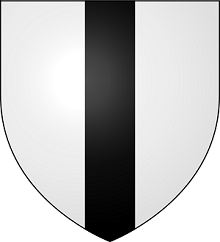
Erskine is an area on the south of the River Clyde, ten miles west of Glasgow. The name is believed to be ancient British for ‘green rising ground’.
Remains of Kildrummy Castle, Aberdeenshire. It was once the seat of the Earls of Mar, and in possession of the Erskines until 1716.
In the early 13th century, during the reign of Alexander II, the first man to take the name as his own was Henry of Erskine, owner of the Barony of Erskine. The family were supporters of Robert the Bruce, and were related to him through the marriage of John of Erskine’s eldest daughter to Thomas Bruce, King Robert’s brother. Success for Bruce brought rewards for Erskine.
David II made Sir Robert of Erskine the Constable and Keeper of the Castle of Sterling. This royal office is still held by the present clan chief today, whose duties include greeting the monarch at the castle gates.
When Alexander, Earl of Mar, died in 1435, Sir Robert Erskine claimed the title. The King, however, withdrew the earldom in 1457, stating that it could only belong to a royal Stewart. After ten years Sir Robert was created the first Lord Erskine.
The 4th Lord Erskine was close to James IV, and after they fell together at Flodden, his son became the guardian of the young James V. The responsibility of custody over young monarchs was given to the Erskines for five generations. Mary, Queen of Scots had been in the care of the 5th Lord Erskine, and following his death, she showed her valuation by restoring to his son, the 6th Lord Erskine, the earldom of Mar.
Barons of Auchterhouse
James Erskine, 6th Earl of Buchan (d. 1640) was the eldest son of John Erskine, Earl of Mar, by his second wife, Marie Stewart, daughter of Esme Stewart, Duke of Lennox. He assumed the title of Earl of Buchan through marriage to Mary Douglas, but the title was confirmed by a royal charter, dated 22 March 1617. The charter states “the countess resigning her rights in his favor, and he was allowed the possession and exercise of all honors, dignities, and precedence of former earls of Buchan”. A decree of the court of sessions, 25 July 1628, restored to Buchan and his wife the precedency over the earls of Eglinton, Montrose, Cassilis, Caithness, and Glencairn, which had been claimed by them, and granted by a former decree in 1606. James became one of the lords of the bedchamber upon accession of Charles I. He lived chiefly in London, where he died in 1640. He was buried at Auchterhouse, Forfarshire. His wife died before him in 1628. He and his wife had six children. Their son James succeeded to the title.
James Erskine, 7th Earl of Buchan (d 1664) was the son of James Erskine, 6th Earl of Buchan and Mary Douglas, Countess of Buchan.1 He married Lady Marjory Ramsay, daughter of William Ramsay, 1st Earl of Dalhousie and Lady Margaret Carnegie, after 11 April 1655. He died in October 1664.
Barony sold
Until this point, a clear pathway can still be traced back to the Ramsay’s of Auchterhouse. According to the Register of the Great Seal of Scotland, the land and Barony of Auchterhouse was sold to John E Ramsay of Lucklaw by James, Earl of Buchan on 15 Dec 1654 for 1746 merks. Other publications discussing Auchterhouse mention that from approximately 1619 until 1695, the parts of the barony of Auchterhouse were held by James, Earl of Moray; Patrick, Earl of Kinghorn; George, Earl of Panmure; James, Earl of Carnwath; and Lady Elizabeth Nevay. The lands and barony of Auchterhouse became whole again on 9 Aug 1695 when they were retoured to John Lyon, 4th Earl of Strathmore. Research, however suggests that the Barony passed from the Earl of Buchan to the Earls of Strathmore, and that the land was held others by permission of the Earl.
The Lyon Family
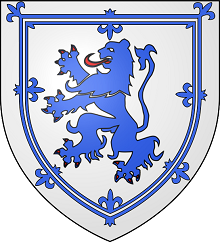
It is generally accepted that the Lyons descended from a French family called de Leon, who came north with Edgar, son of Malcolm III, at the end of the eleventh century to fight against his uncle, Donald Bane, the usurper of the throne. Edgar was triumphant, and de Leon received lands in Perthshire which were later called Glen Lyon. Roger de Leonne witnessed a charter of Edgar to the Abbey at Dunfermline in 1105.
The Lyon’s participated in, and were associated with, several significant events and personalities associated with Scottish history, as well as the United Kingdom.
The 8th Lord Glamis renounced his allegiance to Mary Queen of Scots and served under the Regents Moray and Lennox. He was made Chancellor of Scotland and Keeper of the Great Seal for life, and his son, the ninth Lord, was captain of the Royal Guard and one of James VI’s Privy Councilors. The Third Earl of Kinghorne, as well as other members of the family, was a Jacobite who fought with the Earl of Mar in the rising of 1715 at the Battle of Sheriffmuir. Most recently, the youngest daughter of the fourteenth Earl of Strathmore and Kinghorne was Elizabeth the Queen Mother and last Empress of India.
Barons of Auchterhouse
Patrick Lyon, 3rd Earl of Strathmore and Kinghorne (d.1695) was the son of John Lyon, 2nd Earl of Kinghorne and his wife Lady Elizabeth Maule, daughter of Patrick Maule, 1st Earl of Panmure and Frances Stanhope. Patrick was the grandson of Patrick Lyon, 1st Earl of Kinghorne and his wife Anne Murray.
John Lyon, 4th Earl of Strathmore and Kinghorne (d. 1712), retoured in the lands and barony of Auchterhouse 9 AUG 1695, was the son of Patrick Lyon, 3rd Earl of Strathmore and Kinghorne. He married Elizabeth Stanhope on 21 September 1691 and was succeeded as Earl by his son John Lyon, 5th Earl of Strathmore and Kinghorne. On 21 September 1691, John married Elizabeth Stanhope, daughter of Lady Elizabeth Butler and Philip Stanhope, 2nd Earl of Chesterfield. In May 1695, almost four years after their marriage, he succeeded his father as the 4th Earl of Strathmore and Kinghorne.
The Honorable Patrick Lyon of Auchterhouse (d. 1715) was the second son of Patrick Lyon, 3rd Earl of Strathmore and Kinghorne and his wife Helen, daughter of John Middleton, 1st Earl of Middleton. He married his second cousin Margaret, daughter of James Carnegie of Finhaven and Anna Maitland, but they had no children. He represented the barons of Forfarshire in the last Parliament of Scotland, 1702 to 1707. He was killed fighting on the Jacobite side at the Battle of Sheriffmuir. After the turn of the century, Patrick and Margaret were the primary residents of the manor at Auchterhouse
John Lyon, 5th Earl of Strathmore and Kinghorne (d. 1715) was the son of John Lyon, 4th Earl of Strathmore and Kinghorne. He died fighting with the Jacobites in The Battle of Sheriffmuir in 1715. The barony was re-acquired by the Ogilvy’s in 1715, soon after the death of the 5th Earl of Strathmore and Kinghorne.
The earls of airlie
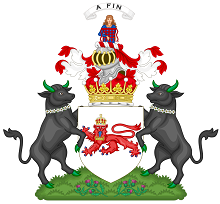
The Ogilvy family, the first official barons of Auchterhouse, recovered the lands and barony of Auchterhouse shortly after the death of Charles Lyon. It has been in their possession until 2020; almost 300 years. The title of Earl of Airlie was created on 2 April 1639 for James Ogilvy, 7th Lord Ogilvy of Airlie, along with the title Lord Ogilvy of Alith and Lintrathen. The title Lord Ogilvy of Airlie was created on 28 April 1491.
In 1715, James Ogilvy, son of the 3rd Earl, took part in a Jacobite uprising against the Crown, and was therefore punished by being attainted; consequently, at his father’s death two years later, he was unable to inherit the title. He was, however, pardoned in 1725. At his death, his brother John was recognized as the Earl, but John’s son David was also attainted, but later pardoned. Then, a cousin, also named David Ogilvy, claimed the title, suggesting that the previous attainders did not affect its succession, but the House of Lords rejected his claim. Parliament later passed an Act completely reversing the attainders; therefore, David Ogilvy was allowed to assume the title. In the list of earls below, the attainders are therefore disregarded for the purpose of numbering.
David Ogilvy, 3rd Earl of Airlie (d. 1717) was the son of James Ogilvy, 2nd Earl of Airlie and Helen Ogilvy. A contract for the marriage of David Ogilvy, 3rd Earl of Airlie and Lady Grizel Lyon was signed on 8 May 1696. His will was proven (by probate) on 17 August 1727. In 1664 under the care of George Halyburton, later Bishop of Dunkeld. He succeeded as the 3rd Lord Ogilvy of Alith and Lintrathen. In 1704. He succeeded as the 3rd Earl of Airlie in 1704. He succeeded as the 9th Lord Ogilvy of Airlie in 1704. His last will was dated 22 March 1716. On his death, the Earldom of Airlie, due to the attainder of his son and heir, became under attainder.
John Ogilvy, Earl of Airlie (d.1761) was the son of David Ogilvy, 3rd Earl of Airlie and Lady Grizel Lyon. A contract for the marriage of John Ogilvy, Earl of Airlie and Margaret Ogilvy was signed on 5 December 1722. He died on 24 July 1761. He was styled as Earl of Airlie in 1731, generally considered at the time to not be affected by his brother’s attainder, and so styled as the 4th Earl of Airlie.
David Ogilvy, Earl of Airlie (d. 1803) was the son of John Ogilvy, Earl of Airlie and Margaret Ogilvy. He married, firstly, Margaret Johnstone, daughter of Sir James Johnstone of Westerhall, 3rd Bt. and Hon. Barbara Murray. He married, secondly, Ann Stuart, daughter of James Stuart and Mary Crauford, in 1770. He was styled as Lord Ogilvy between 1726 and 1783. He joined Prince Charles Edward (‘the young Chevalier’) with a regiment of 300 men, mostly from his own clan. He was attainted for his part in the 1745 Rising, Battle of Culloden. He gained the rank of Lieutenant-General in the “Ogilvy’s Regiment”, for the French Army. On 30 March 1778 he obtained a free pardon under the Great Seal. In 1783 he returned home and confirmed his pardon. He was styled as Earl of Airlie in 1783, self-styled as the 5th Earl of Airlie.
Walter Ogilvy, Earl of Airlie (d. 1819) was the son of John Ogilvy, Earl of Airlie and Margaret Ogilvy. He married, firstly, Margaret Fullerton, daughter of William Fullerton, Lord Spynie, before 31 May 1748. He married, secondly, Jean Ogilvy, daughter of John Ogilvy and Margaret Ogilvy, on 12 November 1780 at Forfar, Angus, Scotland. He and Jean Ogilvy were divorced in 1798. He died on 10 April 1819.
David Ogilvy, 4th Earl of Airlie (d. 1849) was the son of Walter Ogilvy, Earl of Airlie and Jean Ogilvy. He married, firstly, Clementina Drummond, daughter of Gavin Drummond and Clementina Graham, on 7 October 1812. He married, secondly, Margaret Bruce, daughter of William Bruce, on 15 November 1838. He died on 20 August 1849. He was styled as Earl of Airlie between 1819 and 1826.
David Graham Drummond Ogilvy, 5th Earl of Airlie (d. 1881) was the son of David Ogilvy, 4th Earl of Airlie and Clementina Drummond. He married Hon. Henrietta Blanche Stanley, daughter of Edward John Stanley, 2nd Baron Stanley of Alderley and Hon. Henrietta Maria Dillon-Lee, on 23 September 1851 at Alderley, Cheshire, England. He died on 25 September 1881 at age 55 in Denver, Colorado.
Lt.-Col. David Stanley William Ogilvy, 6th Earl of Airlie (d. 1900) was the son of David Graham Drummond Ogilvy, 5th Earl of Airlie and Hon. Henrietta Blanche Stanley. He married Lady Mabell Frances Elizabeth Gore, daughter of Arthur Saunders William Charles Fox Gore, 5th Earl of Arran of the Arran Islands and Lady Edith Elizabeth Henrietta Jocelyn, on 19 January 1886. He died on 11 June 1900 at Diamond Hill, Pretoria, Transvaal, South Africa. He was killed in action leading his regiment in a charge which saved essential artillery. He was a Lieutenant in with the 1st Regiment, the Scots Guards, and the 10th Hussars. He was a veteran of the Second Afghan War between 1878 and 1879.
David Lyulph Gore Wolseley Ogilvy, 7th Earl of Airlie (d. 1968) was the son of Lt.-Col. David Stanley William Ogilvy, 6th Earl of Airlie and Lady Mabell Frances Elizabeth Gore. He married Lady Alexandra Marie Bridget Coke, daughter of Thomas William Coke, 3rd Earl of Leicester of Holkham and Hon. Alice Emily White, on 17 July 1917 He died on 28 December 1968. He fought with the 10th Hussars in World War One from 1914-1918, rising to the rank of lieutenant. He is a decorated veteran who was wounded in combat. The Earl was awarded the Military Cross and mentioned in dispatches. After the war, the Earl attained the rank of Brevet-Lieutenant Colonel in the 4 regiment/5th Battalion of the Black Watch (Territorial Army). He also gained the rank of lieutenant colonel in the Scots Guard. In 1943, the Earl was the commandant of Army Cadet Forces in Scotland. He held the office of a Lord-in-Waiting to HM King George V between 1926 and 1929. He held the office of Lord Chamberlain to HM Queen Elizabeth the Queen Mother between 1937 and 1965.
David George Patrick Coke Ogilvy, 8th Earl of Airlie (b.1926) is the son of David Lyulph Gore Wolseley Ogilvy, 7th Earl of Airlie and Lady Alexandra Marie Bridget Coke. He married Virginia Fortune Ryan, daughter of John Barry Ryan, Jr. and Margaret Kahn, on 23 October 1952. He fought in the Second World War in 1945, in Germany. He gained the rank of Captain in the 2nd Battalion, Scots Guards. He was Aide-de-Camp to the Commander-in-Chief and High Commissioner to Austria between 1947 and 1948. He was Aide-de-Camp to the Commander-in-Chief and High Commissioner to Malaya between 1948 and 1949. He held the office of Lord Chamberlain of the royal household of the United Kingdom from 1984-1997.
The dignity of the barony of Auchterhouse was sold in May of 2020.
chronological list of the barons of auchterhouse until 2020
- Sir Walter Ogilvy (d 1392) married Isabel Ramsey
- Sir Alexander Ogilvy, Sheriff of Angus/Fofar (d 1422?)
- Sir Patrick Ogilvy Sheriff of Angus/Fofar (died at sea)
- Sir Alexander Ogilvy Sheriff of Angus/Fofar (d 1471?)
- Margaret Ogilvy in 1466 married “hearty” James Stewart, Earl of Buchan (resigned office of the sheriff in 1464)
- Alexander Stewart 2nd Earl Buchan (d. 1505)
- John Stewart, 3rd Earl Buchan
- Christian Stewart, Countess of Buchan married Robert Douglas of Lockleven
- James Douglas, 5th Earl of Buchan (d. 1601)
- Mary Douglas married James Erskine (became 6th Earl Buchan) (d. 1640), son of the John 6th Earl of Mar
- James, 7th Earl of Buchan (d 1664)
- Patrick, Earl of Strathmore and Kinghorn (d. 1695)
- John ,4th Earl of Strathmore (d. 1712)
- John, 5th Earl of Strathmore (d 1715)
- David Ogilvy, 3rd Earl of Airlie (d. 1717)
- John Ogilvy, De jure Earl of Airlie (1699–1761)
- David Ogilvy, De jure Earl of Airlie (d. 1803)
- Walter Ogilvy, De jure Earl of Airlie (d. 1819)
- David Ogilvy, 4th Earl of Airlie (d. 1849)
- David Graham Drummond Ogilvy, 5th Earl of Airlie (d. 1881)
- David William Stanley Ogilvy, 6th Earl of Airlie (d. 1900)
- David Lyulph Gore Wolseley Ogilvy, 7th Earl of Airlie (d. 1968)
- David George Patrick Coke Ogilvy, 8th Earl of Airlie (b. 1926)